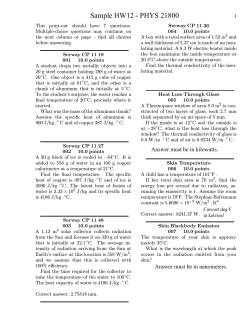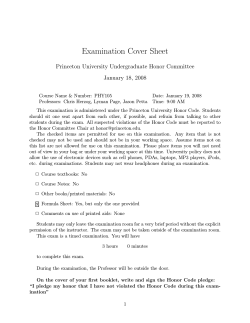
pts.) (5 1. pt.) Why is the sky blue?
Phys 202- Spring 2014 Bogazici University - Department of Physics FINAL EXAM SOLUTIONS 1. (5 pts.) a. (1 pt.) Why is the sky blue? The blue color of the sky is caused by the scattering of sunlight off the molecules of the atmosphere. This scattering, called Rayleigh scattering, is more effective at short wavelengths (the blue end of the visible spectrum). Therefore the light scattered down to the earth at a large angle with respect to the direction of the sun's light is predominantly in the blue end of the spectrum. Reference: http://hyperphysics.phyastr.gsu.edu/hbase/atmos/blusky.html b. (1 pt.) Why is the sunset red? As the Sun gets lower in the sky, its light is passing through more of the atmosphere to reach you. Even more of the blue light is scattered, allowing the reds and yellows to pass straight through to your eyes. Reference: http://spaceplace.nasa.gov/bluesky/en/ c. (1 pt.) Why a diamond sparkles more than a glass of the same shape and size? Diamond has higher index of refraction than glass and consequently a smaller critical angle for total internal reflection. A brilliantcut diamond is shaped to admit light from above, reflect it totally at the converging facets on the underside of the jewel, and let the light escape only at the top. Glass will have less light internally reflected. Reference: Physics for Scientists and Engineers with Modern Physics, Ninth Edition Raymond A. Serway and John W. Jewett, Jr. d. (1 pt.) Why do astronomers looking at distant galaxies talk about looking backward in time? Light travels through a vacuum at a speed of 300 000 km per second. Thus, an image we see from a distant star or galaxy must have been generated some time ago. For example, the star Altair is 16 light years away; if we look at an image of Altair today, we know only what was happening 16 years ago. This may not initially seem significant, but astronomers who look at other galaxies can gain an idea of what galaxies looked like when they were significantly younger. Thus, it actually makes sense to speak of “looking backward in time.” Reference: Physics for Scientists and Engineers with Modern Physics, Ninth Edition Raymond A. Serway and John W. Jewett, Jr. e. (1 pt.) Why can you hear around corners, but not see around corners? Audible sound has wavelengths on the order of meters or centimeters, while visible light has a wavelength on the order of half a micrometer. In this world of breadboxsized objects, ⁄ is large for sound, and sound diffracts around walls with doorways. But ⁄ is a tiny fraction for visible light passing ordinarysize objects or apertures, so light changes its direction by only very small angles when it diffracts. Reference: Physics for Scientists and Engineers with Modern Physics, Ninth Edition Raymond A. Serway and John W. Jewett, Jr. 2. (5 pts.) The wave function for the ground state of hydrogen is ( ) √ ⁄ where is the Bohr radius. a. (2 pts.) Calculate the most probable value of r for an electron in the ground state of the hydrogen atom. b. (3 pts.) Calculate the probability that the electron in the ground state of hydrogen will be found outside the Bohr radius. Reference: Physics for Scientists and Engineers with Modern Physics, Ninth Edition Raymond A. Serway and John W. Jewett, Jr. 3. (5 pts.) Particles incident from the left are confronted with a step in potential energy. The step has a height at . The particles have energy . a. (2 pts.) Write down the wave function Schrödinger equation. for x < 0 (region I). Show that this wave function satisfies the b. (2 pts.) Write down the wave function Schrödinger equation. for x > 0 (region II). Show that this wave function satisfies the c. (1 pt.) Write down the boundary conditions. Reference: Physics for Scientists and Engineers with Modern Physics, Ninth Edition Raymond A. Serway and John W. Jewett, Jr. 4. (5 pts.) The motion of a transparent medium influences the speed of light. This effect was first observed by Fizeau in 1851. Consider a light beam in water. The water moves with speed v in a horizontal pipe. Assume the light travels in the same direction as the water moves. The speed of light with respect to water is ⁄ , where is the index of refraction of water. Find the speed of the light measured in the laboratory frame in terms of c, v and n. Reference: Physics for Scientists and Engineers with Modern Physics, Ninth Edition Raymond A. Serway and John W. Jewett, Jr.
© Copyright 2025





















